Muro Box N40 Update #11-
Sublime’s 4-Comb Design and Function
During the development process of N40, we received numerous inquiries from music box enthusiasts regarding the details of the two versions, “N40 Sublime” and the “N40 Standard”. These inquiries covered differences in sound, as well as the impact of variations in the base material.
Although both N40 models can play 40-note melodies, the primary difference is that only the N40 Sublime features 80 comb teeth in total to produce the sublime harmony effect during play. But how does sublime harmony work?
Some customers have noticed that “N40 Sublime” has 2 extra combs compared to the “Standard Version,” and these 2 extra combs are installed upside down on the brass base. Durability and limitations regarding the striking speed of these combs are also what they wish to know.
We have compiled everyone’s inquiry about the development for N40 Sublime, and we are going to reply to those questions one by one in this update. Let’s dive into it together!
Table of Contents
The Origin of N40 Sublime
First of all, I want to express our gratitude to Mr. Siegfried Pattyn for introducing the concept of Sublime Harmony to us. Initially, when we first heard about it, we were quite puzzled and had no understanding of how it worked or why a deviation of -14 cents would produce a vibrato effect. Therefore, we initially kept this concept in our minds but did not adopt it.
So, the original plan for the N40 project was to commission Kyooh Precision Industry Co., LTD.(who has produced various traditional music box movements for more than 40 years) to develop a new comb that could support 40 notes at once, with a length of 12 centimeters.
However, upon closer examination, we had a sudden realization. Why don’t we achieve the Sublime Harmony configuration immediately by simply adding or reversing two vibration plates to the current N20 cylinder (drum) design?
This led us to have two development options:
1.Develop a completely new comb: This would involve taking the risk of comb development failure and designing a 12-centimeter drum from scratch. Only after successfully accomplishing all these steps could we finally test the effects of Sublime Harmony.
2.Use the existing comb: This would allow us to directly upgrade to Sublime Harmony!
So, after weighing the difficulties and risks of development, we decided to use the existing N20 music box base as a starting point and design a new model to make “sublime harmony” as its main feature.
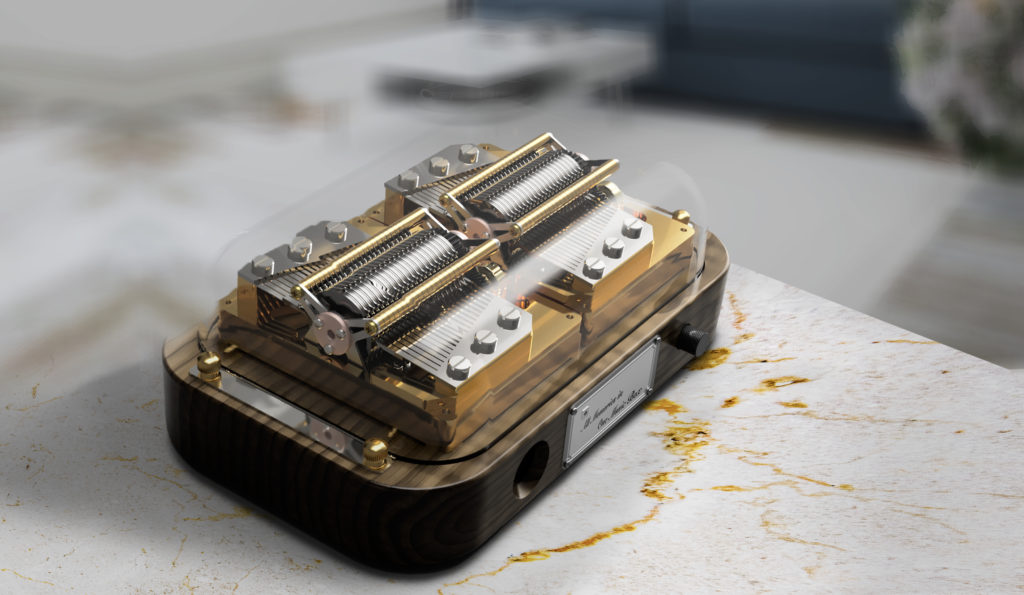
Let’s Preview the First N40 Sublime Prototype!
Which design is better for the N40 model: 1 comb with 40 notes or 2 combs with 20 notes on each?
Since multi-comb music boxes are quite rare, the first question we pondered was why existing music box models aren’t designed this way. Could it be because the sound quality is not satisfactory, leading to a lack of interest? We asked Mr. Longxi Huang, the General Manager of Kyooh Precision Industry Co., LTD., this question many times.
There are very few people on Earth who can answer this question because those with actual experience in developing music box movements are extremely scarce. The following answer is based on the knowledge I gained during the design of music boxes, and I apologize if it differs from the facts.
Firstly, multi-comb are actually quite common; it’s just that their unit prices are usually higher, leading to lower circulation in the market. For example, the collection found in the Modern Music Box Museum in Taiwan consists of two bases with a total of 100 notes, comprising 50 notes each. There is a mechanism hidden underneath these two bases, where only one of them can be wound up, but it simultaneously drives the rotation of both cylinders at the same speed. This design was clearly created for the purpose of Sublime Harmony. The price of this music box is about $3,421 USD.
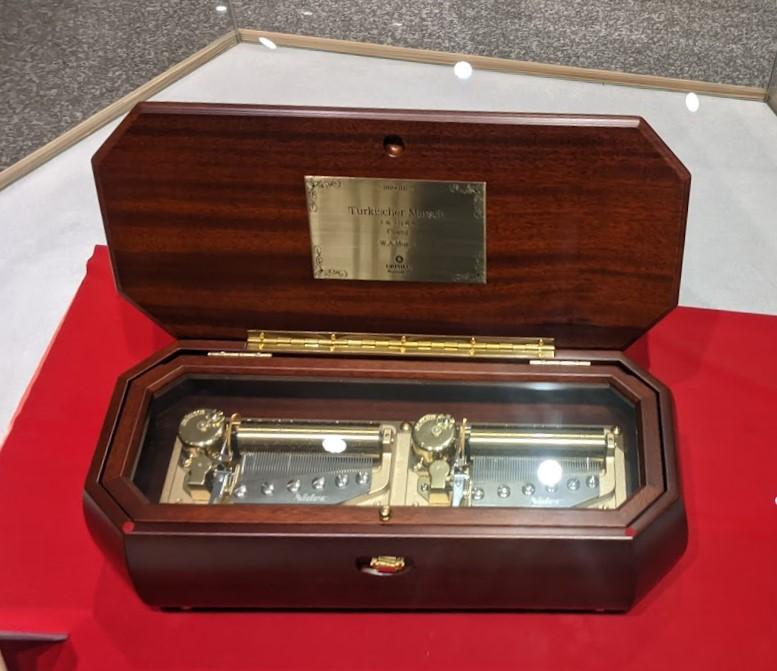
What about the difference in sound? My conclusion is that the total width of the comb itself is not the key factor of the sound effect; it’s the shape of each tooth that defines the sound characteristics.
Muro Box’s comb design originated from Kyooh’s 20-note paper strip music box, and its sound characteristics are somewhat thicker. To accommodate the width of the punched holes in the paper strip, the teeth are wider. With the goal of not adding extra lead weights, the teeth were intentionally designed to be wider to increase their body weight, and the base of the comb teeth was cut thinner.
So, even though both combs originated from Kyooh, music boxes with more notes of the same brand don’t have these limitations. Typically, their teeth are narrower and the base of the teeth is thicker, resulting in a more pronounced (sharp) sound.
Is the total number of notes in a comb a measure of its quality? I don’t think so. There are indeed differences in sound characteristics, but just like how everyone has different accents, the sound quality is subjective. As long as you like it, it’s good, isn’t it?
So, after I finally understood the principles behind comb’s sound characteristics, I didn’t insist on developing a new 40-note comb with a 12-centimeter length. Due to our mechanical constraints, the spacing between each note is fixed at 3mm, and Kyooh cannot use lead weights on the comb, so the thickness of the teeth won’t change either. As long as these two factors remain unchanged, the sound effects of two shorter combs and one long comb will be similar, and there’s no need to reinvent the wheel.
Will the N40 Sublime’s brass base make it generate better sound?
The answer is that it is not necessary. If you feel that a longer and smoother sustaining effect is a characteristic of a good music box, then the answer is “better.” However, if you prefer a clear and distinct separation between each note and don’t find longer sustain appealing, the extended sustaining feature might not be attractive to you. For example, we found that traditional musical instruments players may prefer to have a clear and distinct separation between each note, so the extra long sustaining effect is not appealing to them.
The sustaining characteristics of the N40 Sublime is not primarily due to the brass we used for its metal base. The sustaining characteristics are related to the overall increase in the weight and making the sound more prolonged and mellower. Even if the base were made of a zinc alloy with the same weight, the result would still be very close, with a similar legato effect.
As for why an increase in weight leads to longer sustaining effect and mellower sound, you can think of the base as a battery that stores the energy of vibration. If the base has a smaller mass, there is less energy stored in the base, and any unused energy is immediately released as sound, resulting in a louder but shorter sound. To provide a more obvious example, small music boxes made in China typically have light bases, causing the sound to be released all at once, resulting in a loud but somewhat distorted sound. Conversely, with a heavier base, the vibrational energy is stored in the base and slowly released, resulting in a quieter but longer sustaining sound effect.

Regarding the choice of base material, we also consulted Mr. Longxi Huang, the General Manager of Kyooh. While weight is indeed the single most important factor affecting sound, production considerations also include another critical factor: cost. Kyooh has previously tested various base materials, such as cast iron, which produced acceptable sound quality but had low precision and high post-processing costs, so it was not adopted.
So, why do most music boxes now use zinc alloy? It’s because zinc alloy has a higher specific gravity (Relative density 6.7, slightly lower than brass at 8.5), low processing costs, can be formed in a single casting with high precision and no need for additional postprocessing, making it the most cost-effective metal among all types of metal processing, hence its widespread use.
You might wonder why not use aluminum? Aluminum has a very low specific gravity (2.7), which means it requires twice the volume compared to zinc alloy to achieve the same weight, making it unsuitable in terms of cost and space utilization.
As for brass, while brass is a heavy material, it comes with a high unit price, high casting costs, and low precision, requiring extensive post-processing adjustments. Considering the cost, it’s not a wise choice for mass-producing music boxes.
So, why did the N40 Sublime model choose to use brass, a high-cost material? Because it’s a personal preference! Think about it, wouldn’t it be boring to use the same zinc alloy as other music boxes? Brass was the base material used by the ancestors of music boxes, and by paying tribute to antique music boxes with a brass base, it adds a touch of elegance with its metallic hue. If you like it as I do, do you need any other reasons?
Will the heavy brass base affect the volume of the N40 Sublime?
Absolutely!
The weight of the base doesn’t necessarily mean the heavier, the better. Each base has a corresponding “minimum vibration force” that needs to be overcome. Sound will only be produced when this force is exceeded, otherwise, the sound will remain muted and quiet, like an ant attempting to shake a tree. This is also one of the reasons why higher-priced music boxes generally have smaller volume. However, when designing a music box, loud sound is not the sole core value; exterior details and the tactile feel of the weight are also the priorities.
In the case of the N40 Sublime, using a brass base brings the total weight to 3.5 kg, so the normal volume will be even lower than the N20 model. Therefore, for the N40 Sublime model, we will offer options that allow customers to choose their preferred volume:
– If you intend to use the music box in a bedroom, we would recommend the version with the normal volume (which is quieter than the N20), offering a comfortable volume for quiet indoor settings.
– However, if you plan to record the music, the normal volume may not be suitable because what the human ear can perceive, a microphone may not capture entirely. If you intend to use it in a large living room or for performances/recording, you can choose the special configuration version of the comb to make the sound louder and the details clearer. Keep in mind that it may be a bit too loud for use at night when your neighbors might also hear the music box’s sound if the building has a poor soundproof design.
Why are there 2 separate metal bases in one N40 Sublime?
We plan to release the N20 Sublime Harmony version in the future so that it can share the same metal base design like the N40 models.
N40 should have 40 notes, but why are there 80 comb teeth in N40 Sublime?
In simple terms, the principle of “sublime harmony” involves overlaying two slightly offset frequencies of sound. Due to the physical properties of sound wave interference, the combined sound will continuously fluctuate in volume based on the difference in frequencies, creating a perceived tremolo effect.
In the case of large music boxes without cost constraints, they often employ a dual-disc or dual-comb design to address this issue. Those interested in observing the effect of large high-end music boxes using dual combs can watch the video linked below.
To achieve the simultaneous emission of two frequencies with a slight offset on the Muro Box, we utilize the design of our patented cylinder. The Muro Box cylinder has eight symmetrical pins for each note’s plucking movement. As it rotates, when one pin moves upward, the diagonally opposite pin moves downward at the same speed. Therefore, if we place an additional comb on the opposite side of the cylinder, designed to move downward, both combs—one moving upward and one moving downward—will be activated simultaneously, creating a harmonious blend of frequencies with a slight offset. (This is also the reason why customers like Siegfred, discovered that two of the four combs in N40 Sublime are installed in reverse.)
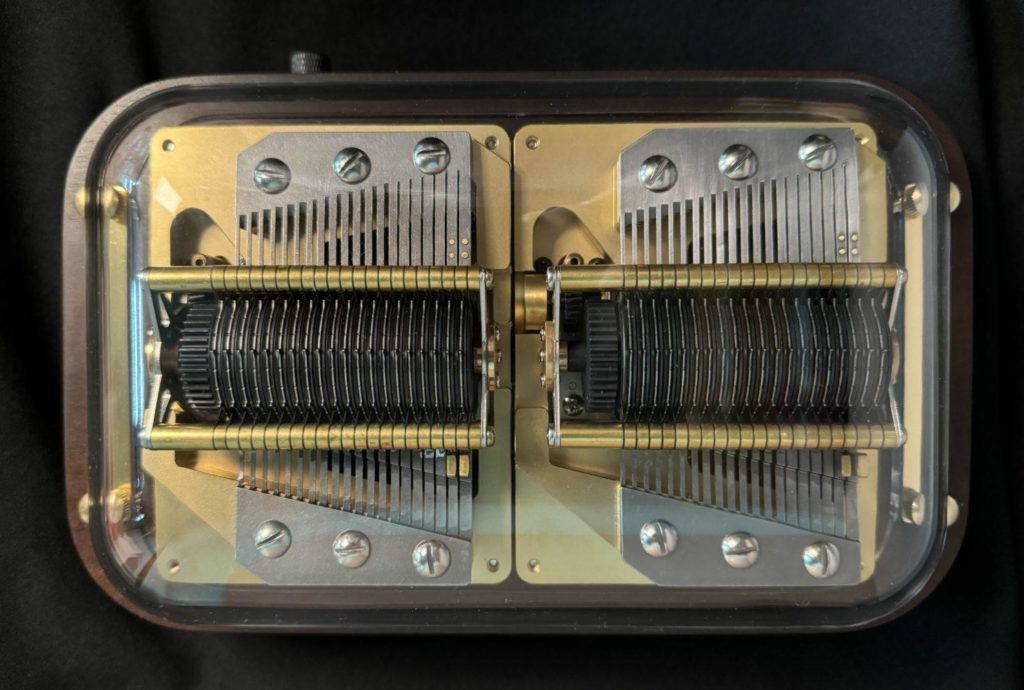
So, what we need to do is to place a comb with a tuning difference of -14 cents on the opposite side of the original comb. This comb will automatically be activated by the two diagonally opposite pins on the cylinder, achieving the special effect of sublime harmony. By adding two combs tuned at -14 cents and installing them in reverse, we have added 40 additional notes, resulting in a total of 80 tuned notes on the 4 combs.
In fact, Mr. Huang Longxi, the General Manager of Kyooh, has reminded us several times that, following the conventions of the music box industry, N40 Sublime should technically be called N80 Sublime because we provide 80 different notes.
However, after careful consideration, we decided to name it from a musician’s perspective. In practical terms, there are only 40 notes that can be played during arrangement, while the remaining 40 notes are for auxiliary purposes and cannot be chosen during composition. Therefore, N40 is a more accurate and practical name for the product.
Does “Sublime Harmony” sound great to me?
We love it, but it might not be to everyone’s liking. Especially if you prefer clean sound with distinct separation between notes, the tremolo effect of sublime harmony may not necessarily suit your taste. Sublime harmony is an important technique in music boxes, representing a cultural heritage of 200 years, steeped in tradition and luxury, but it’s not a necessary feature when the music box is used as a musical instrument.
Therefore, N40 Sublime will provide an additional option. With the same brass base, you can choose not to use the two sets of combs with a 14-cent tuning difference and instead opt for combs with the same frequency. This way, while enjoying the exquisite appearance, you can also achieve a purer sound and higher volume, which may better meet your expectations.
The N40's comb scale is not sequential but rather interleaved!
Did you know that the scales of N40 are not in sequential order but are interleaved? N40’s two or four combs have their scales arranged in an alternating pattern, unlike a keyboard where the notes are arranged sequentially in ascending order. Please take a look at the animation below, demonstrating the actual situation of “interleaved scales”:
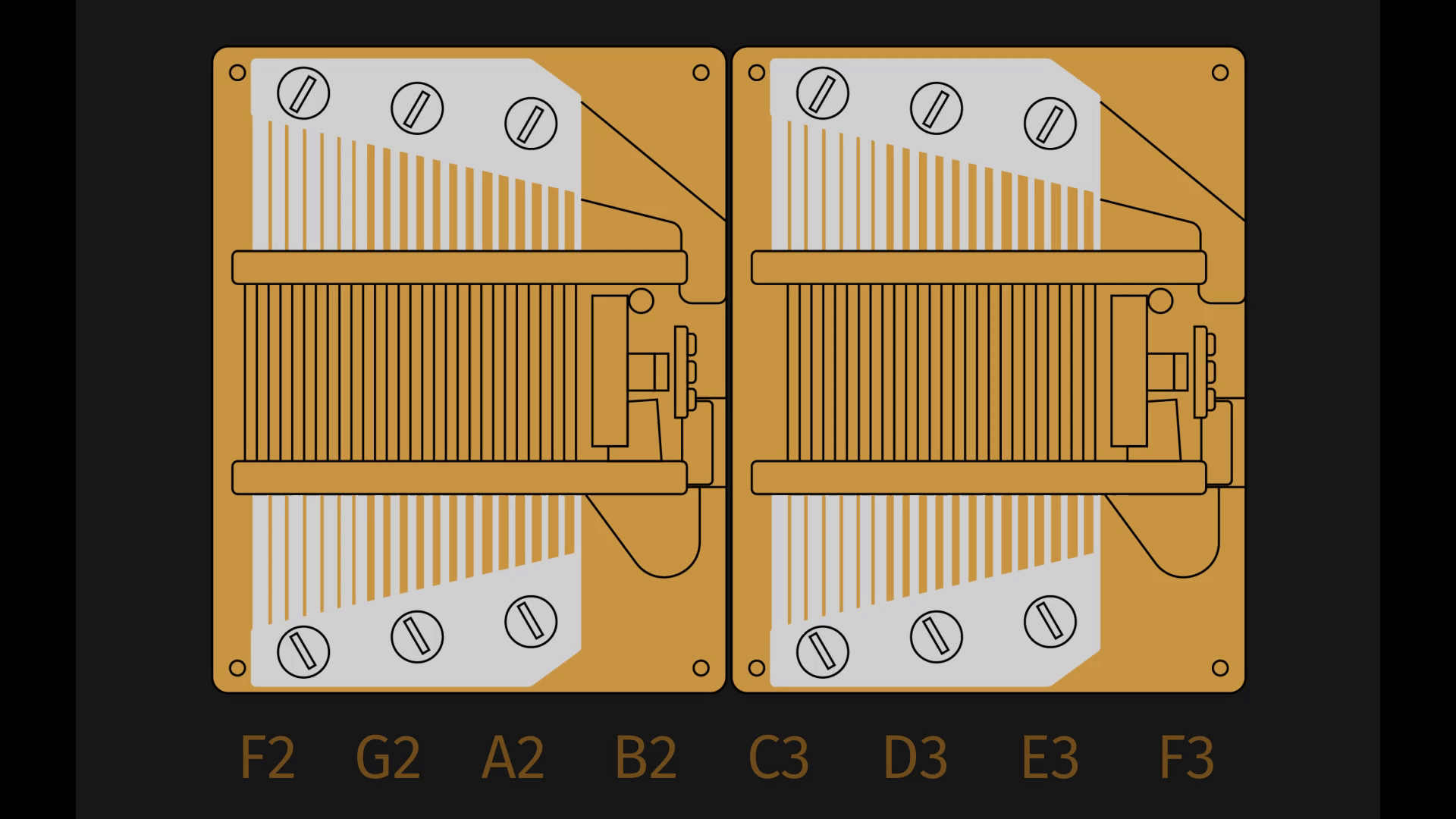
There are two sets of combs on both the left and right sides. The lower set of combs maintains the original pitch, while the upper set is tuned to -14 cents. The notes are arranged in an interleaved pattern from left to right, along with their corresponding frequencies. We have divided them into two tables based on the left and right combs.
On the left comb, it starts from the low G2:
| Note | 2 | 4 | 6 | 8 | 10 | 12 | 14 | 16 | 18 | 20 | 22 | 24 | 26 | 28 | 30 | 32 | 34 | 36 | 38 | 40 |
|---|---|---|---|---|---|---|---|---|---|---|---|---|---|---|---|---|---|---|---|---|
| Note Name | G2 | B2 | D3 | E3 | F#3 | G#3 | A#3 | C4 | D4 | E4 | F#4 | G#4 | A#4 | C5 | D5 | E5 | F#5 | G#5 | A#5 | C6 |
| Original Frequency | 196.0 | 247.0 | 293.7 | 329.6 | 370.0 | 415.3 | 466.2 | 523.3 | 587.3 | 659.3 | 740.0 | 830.6 | 932.3 | 1046.5 | 1174.7 | 1318.5 | 1480.0 | 1661.2 | 1864.7 | 2093.0 |
| -14 cent Frequency | 194.4 | 245.0 | 291.3 | 326.9 | 367.0 | 412.0 | 462.4 | 519.1 | 582.6 | 654.0 | 734.0 | 823.9 | 924.8 | 1038.1 | 1165.2 | 1307.9 | 1468.1 | 1647.8 | 1849.7 | 2076.1 |
On the right comb, it starts from the low F2:
| Note | 1 | 3 | 5 | 7 | 9 | 11 | 13 | 15 | 17 | 19 | 21 | 23 | 25 | 27 | 29 | 31 | 33 | 35 | 37 | 39 |
|---|---|---|---|---|---|---|---|---|---|---|---|---|---|---|---|---|---|---|---|---|
| Note Name | F2 | A2 | C3 | D#3 | F3 | G3 | A3 | B3 | C#4 | D#4 | F4 | G4 | A4 | B4 | C#5 | D#5 | F5 | G5 | A5 | B5 |
| Original Frequency | 174.6 | 220.0 | 261.6 | 311.1 | 349.2 | 392.0 | 440.0 | 493.9 | 554.4 | 622.3 | 698.5 | 784.0 | 880.0 | 987.8 | 1108.7 | 1244.5 | 1396.9 | 1568.0 | 1760.0 | 1975.5 |
| -14 cent Frequency | 173.2 | 218.2 | 259.5 | 308.6 | 346.4 | 388.8 | 436.5 | 489.9 | 549.9 | 617.3 | 692.9 | 777.7 | 872.9 | 979.8 | 1099.8 | 1234.5 | 1385.6 | 1555.4 | 1745.8 | 1959.6 |
Why did we do this? We’ve already explained the reasons for choosing two sets of 20-note combs in the previous section, and these two combs have identical prototypes before polishing, with their thicknesses adjusted to achieve the desired pitch.
So, the production of “each comb having both high and low notes” is more efficient and ensures stable quality compared to “one comb focusing on low notes and the other on high notes.” This is why the scales in our 40-note music box are played with two interleaved combs. When you’re enjoying the soothing mechanics of the music box, this misaligned rotation is not just visually intriguing; it also reflects the thoughtful design behind it!
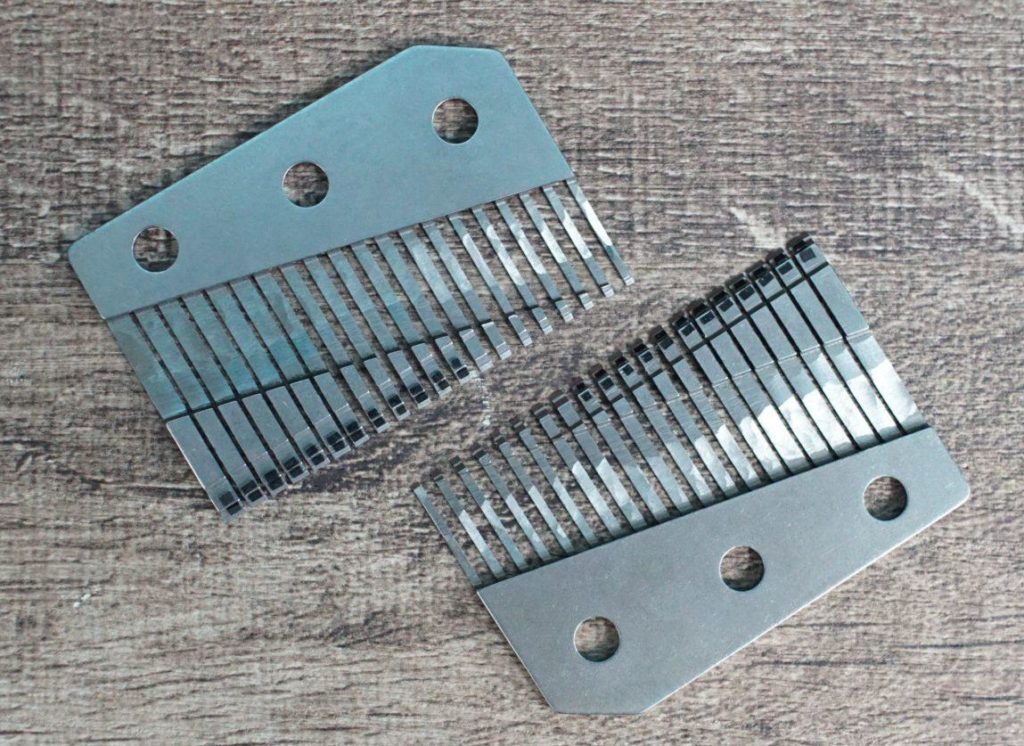
Where can I listen to the live performances of N40 Sublime and N40 Standard to compare their different sound effects?
Muro Box-N40 | Comparing the Sound of Sublime vs. Standard with "My Grandfather's Clock"
Welcome to our online music library! Use songs you are familiar with to compare the actual sound of different Muro Box models:
1. Enter the song title or artist name in the search bar of the online music library.
For example, we will use Canon as a keyword. Since Canon has many different versions and arrangement styles, we highly recommend this version arranged by our official arranger: Canon in Muro Box.

2. The “Web” tab on the screen means that the playback uses the app’s digital simulation sound. To switch to the actual music box performance, please click the tabs labeled with the other model names: N20 / N40 / N40SLM.
Please note: the gray box with a number after the song title indicates the note range used by the arranger and which model it corresponds to.
A 20-note song can be played on both N20 and N40, because the 40-note model includes the full 20-note range.
However, if you play a 40-note song on the N20, some notes will not sound because they exceed the N20’s playable range.

3. Click on the model you want to listen to:
- “N40 SLM” means you want to listen to this song on the N40 Sublime model.
- “N40” means you want to listen to the standard N40 model.
- “N20” means you want to listen to the N20 music box.

4. Make sure to turn the volume of the video player to the maximum, so you can clearly hear the music box performance.
We will be holding offline listening events at our headquarter office in New Taipei City, Taiwan. Welcome to schedule your visiting time by email us (support@tevofy.com).
Here are the upcoming public events where you can participate in on-site demonstrations. Please remember to register early when sign-ups open and reserve time slots to join our listening events:
Taichung City: Maker Faire at Feng Chia University Gymnasium (2023/10/14 Saturday~2023/10/15 Sunday, 9:30-17:00).
Tainan City: Lecture + Listening Event at Nanxin Junior High School (2023/11/04, Saturday morning).
Taipei City: Lecture + Listening Event at the National Central Library – Multimedia Creative Experimentation Center: Open Lab (2023/11/11, Saturday afternoon).
If you know of any locations in Hsinchu city or Kaohsiung city where we can hold Muro Box lectures and listening events during our crowdfunding campaign period (late October to late November in 2023), please assist us by recommending suitable sites for us!
Below are records of public lectures we held in early September in Taipei, where we brought the first N40 Mu Feng Edition for people to try out on-site:


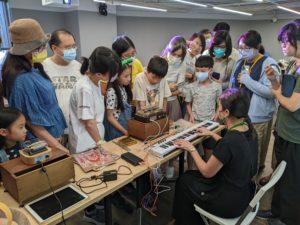
Is it possible to switch which songs should have the special "sublime harmony"and which song should be played without using this effect?
The N40 sublime will only be able to play one harmonized sound (double sound) for each note because our app will not be able to control which note only knocks once to generate the single sound or which note to knock both the original note and its -14 cent note.
If you remove the -14 cent combs manually, then it will only play the single sound like the N40 Standard. However, we do not recommend our user manually remove the comb because they will have difficulty installing them back to the same location precisely when they wish to hear the sublime sound again.
The degree of engagement between the comb teeth and the pins of the rolling cylinder will make a clear difference in terms of music volume. Too much engagement may break the comb teeth after long time use, and too little engagement will make it generate music with less volume.
How many notes can be played simultaneously? Is there a speed limit for playing music? Are there any limitations on song length?
(1) Playing Speed Limitation: The maximum speed for repeated notes is 4 beats per second, which means that in terms of eighth notes, you can achieve up to 120 beats per minute when playing the same note continuously. You can simultaneously play up to 10 notes at the same time. We consulted with our arranging teachers and established a standard for high-speed continuous notes, which is four beats per second. This means that the same note should be able to be tapped continuously four times per second. While this speed has its limitations, most songs can be played or adjusted through arrangement to replace or omit overly fast and repetitive notes. Please note: If the speed of playing the same pitch exceeds four times per second, the music box will skip notes that go beyond this speed limitation.
(2) File Format Limitation: The Muro Box products, regardless of the model, can only read single-track MIDI files and does not support other formats.
(3) Range Limitation of N40 Model: The lowest note is F2, and the highest note is C6, including all half-tones from D3 to C6 in the continuous range. In the lower octave (between F2 and C3), the following semitones are missing: F#2, G#2, A#2, C#3. For details on why we decided to omit these four half-tones, please refer to our N40 update #8.
(4) Song Length Limitation: In the app settings, the maximum length for each song that can be played is 30 minutes to ensure that there is enough working resource for your mobile device.
How durable are the combs? Have you conducted any experiments for durability? What is the process for repairing or replacing comb parts in case of malfunction?
The comb materials used in all Muro Box models are supplied by Kyooh Precision Industry Co., Ltd., which is located in Taichung city, Taiwan, with a history of over 40 years in producing music boxes. The combs they manufacture have a lineage of Japanese design.
Muro Box uses specially designed 20-note combs that have undergone pressure tests for 1000 hours during the design phase. However, it’s important to note that combs themselves are consumable parts and may experience wear and tear or breakage over time.
We strongly advise customers not to attempt comb assembly themselves, as even the slightest error during assembly can potentially damage the comb. We provide a one-year warranty and three years of after-sales service, so please feel free to use your music box without worries. If any maintenance or repairs are needed, you can rely on us to handle the work for you.
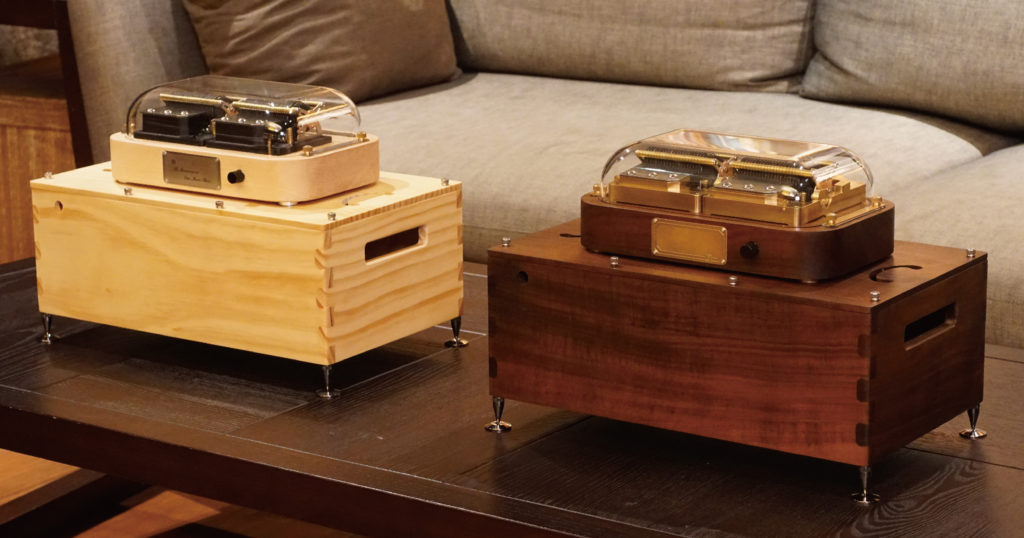
Pre-order
Muro Box-N40
Get Voucher before Kickstarter Campaign Starts
Limited Time Voucher: Available before our Kickstarter Campaign Starts on Oct. 26th 2023. Prepaid $30 USD to Save Your DHL shipping fee $90.
If you decide not to pledge to our campaign, the voucher is 100% refundable.
If you think the N40 Sublime/N40 Standard, or N20 Lite Battery version is what you like, please prepaid $30 in our store now to help us estimate the amount of new orders for the new models. We hope to start purchasing their components sooner so that we can ship the goods in 4 months after our Kickstarter campaign ends.
In our Kickstarter campaign, all of the pledge options will not include shipping fee. We will collect the shipping fee after the campaign when we can make sure each pledge option’s packaging box size. However, we will give a shipping price range table to show the quotes for airmail and DHL options in order to let backers know the estimated shipping cost.
To thank for your super early support for our Kickstarter campaign by purchasing our store’ voucher before our Kickstarter campaign officially starts (The Launch Date is TBA this October, 2023), we will automatically waive your shipping fee and use DHL to ship your order.
This automatic DHL shipping waive is worth 90 USD because both N40 models and N20 Lite Battery versions are large and heavy items for international air shipping.


